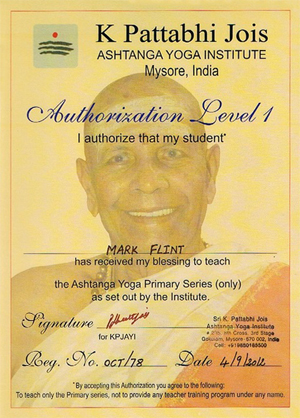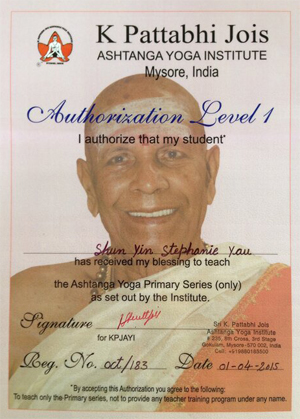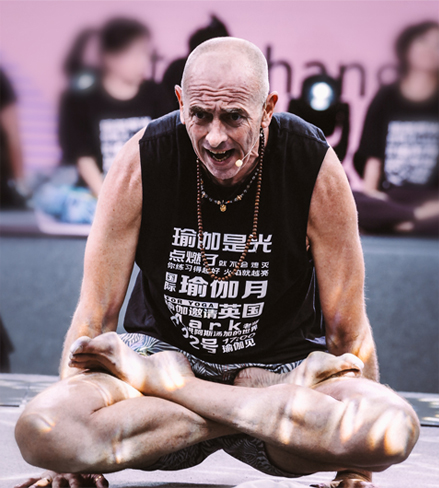 I was diagnosed with rheumatoid arthritis in 1992. I’d always been fit, athletic. I was an ex-professional golfer. I was used to my body working as it should work. When I was diagnosed with rheumatoid arthritis I was advised to take a steroid a day for the rest of my life or I would end up in a wheelchair. I chose not to take this advice. Instead, I stopped taking all allopathic drugs — painkillers, anti-inflammatories etc.
I was diagnosed with rheumatoid arthritis in 1992. I’d always been fit, athletic. I was an ex-professional golfer. I was used to my body working as it should work. When I was diagnosed with rheumatoid arthritis I was advised to take a steroid a day for the rest of my life or I would end up in a wheelchair. I chose not to take this advice. Instead, I stopped taking all allopathic drugs — painkillers, anti-inflammatories etc.
I went on a course of discovery about how I could put my body back together without resorting to allopathy. I tried the usual alternative therapies. I knew that yoga could help me. But back then in England, this was the early 1990s, there was not much yoga.
I decided I wanted to leave England and set up a home abroad. First I looked at South Africa, but it was the wrong time politically. I travelled to India on vacation in January 1999 not thinking I would find the place I wanted to settle. But towards the end of my trip I visited Mysore and instantly fell in love with this special city. I didn’t know Mysore was famous for yoga, or for ashtanga yoga in particular at that time. The climate, the architecture, and the surrounding countryside — jungle, rainforest and mountains — was all enough to help me make the decision.
I returned to UK and decided Mysore was where I wanted to live, I sold my properties and in October 1999 I was on my way to India with all my possessions following in a shipping container. Within two days, while still living at a hotel, I enrolled in a yoga class at the Ayurvedic hospital, which is not really what people are looking for when they come to Mysore with this vision of Mysore yoga. I was in this dirty old hall, doing something that was not really what I was searching for. But I took from it what I could, and went on and tried to find another teacher. I tried several teachers in Mysore, until finally coming across Shiva Kamal, one of Venkatesh’s main students, and holder of the Indian Yoga Championship for some nine years. I was learning under the direct guidance of this guy, it was one on one, for a long time, practicing hatha. Then, one day he came and said he had been offered a chance to teach abroad, so I lost my teacher.
I started doing a self practice at home. I changed over to the ashtanga series, but without vinyasa, because I thought vinyasa was a bit hard for my body. I started practicing the ashtanga series but in a hatha way. In 2008, I had some bad business experiences, there was a global economic slump on, and I decided I was going to dedicate more time to yoga. So I went to see Sharath — I knew Sharath and Guruji socially by this time — and asked if I could practice with him. The one thing he asked me for was dedication, for a dedicated practice. I could give him that, because I’d put things on hold, taken a sabbatical. Even though I’d been living in Mysore for seven or eight years, I’d been travelling around India, doing business. I joined his indian class in the afternoons, and it was under Sharath’s personal tutelage that I went through the series. Before I’d had a little bit of a lazy practice, I thought there were asanas that I couldn’t do, and I told Sharath about this. But as the class progressed, he just made me do them. I’d never had a strong teacher before. Now I had this teacher who made me do everything. It was through his teaching that I discovered so much more about my body and what was possible through the ashtanga method.
In 2012, he authorised me to teach, and since then, I’ve continued teaching the traditional method. I teach quite a lot in China. I prefer to teach beginners, because you’re setting someone up for the practice. There are so many people out there who don’t understand traditional ashtanga. A lot of ashtanga is being taught by people who have done some 30-day teacher training. I bring my students back to basics — bandha, breathing, and drishti. I get my students to practice with awareness, to get into the tune of the breath. I explain that if we give over to the breath, we are able to get the maximum out of the practice. It is not what asana you practice it is how you practice the asana.
Pattabhi Jois used to say ashtanga yoga is all about learning to breath, and I think this is the most important factor for us. When we’re born we inhale; when we die, we exhale. Everything between that is inhaling, exhaling. If we have short breaths, we have a short life. If we take long breaths, we have a chance at a long life. I believe we’re allocated so many breaths when we born, and it is our choice, we can take it in short breath or long breaths. So breath is the most important thing.
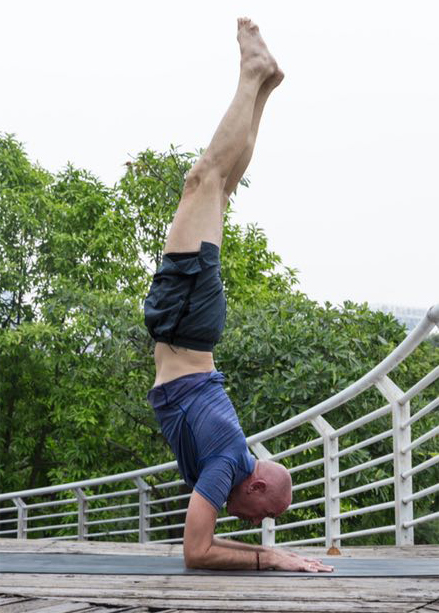
I didn’t know they were here! Back then, there wasn’t a lot of tourism, there weren’t a lot of yoga shalas and yoga students in Mysore. As a foreigner, you’d jump in an auto-rickshaw, and automatically they’d assume you were going to the old shala. So I’d end up there all the time. And I’d be like “No! I don’t want to go here.”
Within the first week of moving to Mysore, I’d become a member of the local golf club. I’m a former professional golfer. Through that golf club membership, I’d met lots of Mysorians, especially doctors. Pattabhi Jois didn’t have a good reputation within the Indian community, because Ashtanga is a demanding practice. A lot of Indians, by the time they get to thirty, they’re already middle aged. He was a strong teacher, a very demanding teacher. If you’re not ready to give in, you could get an injury from the old way he used to teach. So that was my understanding of Pattabhi Jois.
I’d met Sharath and Guruji socially, I was familiar with them as a family. In 2009, when I went to ask Sharath if I could practice with him, in his usual way he looked straight through me. I actually had to ask, “You do know me?” He said, “Yes, Mark, I do.”
When you know Sharath away from the shala, he’s a different person. But he’s got to adapt his personality. He’s got to be a little bit untouchable or he’d have 400 yogis at his door every morning. He’s got to maintain this separation of teacher/guru.

I didn’t know they were here! Back then, there wasn’t a lot of tourism, there weren’t a lot of yoga shalas and yoga students in Mysore. As a foreigner, you’d jump in an auto-rickshaw, and automatically they’d assume you were going to the old shala. So I’d end up there all the time. And I’d be like “No! I don’t want to go here.”
Within the first week of moving to Mysore, I’d become a member of the local golf club. I’m a former professional golfer. Through that golf club membership, I’d met lots of Mysorians, especially doctors. Pattabhi Jois didn’t have a good reputation within the Indian community, because Ashtanga is a demanding practice. A lot of Indians, by the time they get to thirty, they’re already middle aged. He was a strong teacher, a very demanding teacher. If you’re not ready to give in, you could get an injury from the old way he used to teach. So that was my understanding of Pattabhi Jois.
I’d met Sharath and Guruji socially, I was familiar with them as a family. In 2009, when I went to ask Sharath if I could practice with him, in his usual way he looked straight through me. I actually had to ask, “You do know me?” He said, “Yes, Mark, I do.”
When you know Sharath away from the shala, he’s a different person. But he’s got to adapt his personality. He’s got to be a little bit untouchable or he’d have 400 yogis at his door every morning. He’s got to maintain this separation of teacher/guru.
Golf was something I started from a very early age. My father, he liked golf. I started playing when I was ten years old, I dedicated my life, pretty much, to it. I turned pro when I was sixteen years old, which I maintained for two years. I approached it wrong. My weakness with my golf was my mind. If I’d been able to develop a yoga and meditation practice back then, I know those things would have helped me in my golf.
I’ve been working with the Indian Golf Union and some top South Indian junior female golfers. I’ve incorporated ashtanga yoga into golf, because I think the bandha is very relevant to the golf swing. I’ve also introduced them to the breathing. What happens a lot with youngsters is they get really nervous and they destroy it all in the last two or three holes. If they can employ the right breathing techniques they can get past that problem. In practice, it has really been working for these girls, they’re going from strength to strength. I hope to bring this approach to more golfers, especially in China. It could benefit so many.
After being diagnosed with arthritis, I went on my own voyage of discovery. This included not taking painkillers — pain was a signal for me, inflammation was a signal for me. I had to really assess what was happening with my body. First of all, I fasted, and then slowly introduced foods from the good list. It was self-experiments all the way through. It starts with diet. But we need more than diet, we need to open up the joints, open up the fascia in the body, get the blood flowing again. Arthritis is a circulatory disease, so all these long deep stretches, getting the blood flowing to those lazy joints, I think that is where a lot of the cure comes from. But you’ve got to stop putting the poison into your body. And then you can begin that healing process, and let your body work correctly. It’s the bad elements of food, that destroy us. But we choose that from our western lifestyle.
There’s a list of items that are good for health. We all know it! It’s just modern food choices have taken us away from it. The most harmful thing for most people is the additives they put in foods.
I think it is an individual thing. Some people do need meat, and some people don’t. I believe your body would be more open, flexible without meat products. But there’s no point having a flexible body if it is weak, you’d just open yourself up to injury. So you’ve got to respect your body type and give it what it needs, and in some cases this does mean meat. What is right for some is not always good for others. But I think it does benefit the practice. We all know if we have a big strong meal, practice is going to be hard the next day. If you’re eating meats which are not easily digested and they stay in the system longer, it’s not hard to work it out. You’ll feel it in your own practice when you’re sluggish.
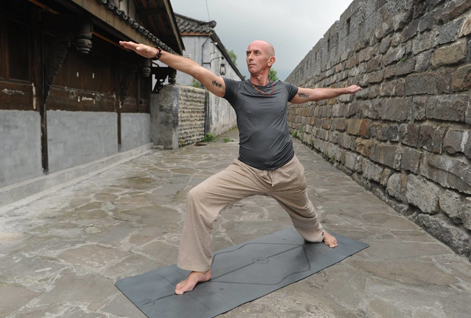 Start with the hands. For rheumatoid arthritis sufferers, that’s where we see the first deterioration, it’s the first thing that goes. In downward facing dog — as yogis, we all do it — we spread the fingers. If your fingers are closing up from arthritis, and you don’t straighten them out daily, they’re going to close up even more. But you can reverse the process, by extending the hands daily, putting pressure through the fingertips, extending throughout the base between finger and thumb.
Start with the hands. For rheumatoid arthritis sufferers, that’s where we see the first deterioration, it’s the first thing that goes. In downward facing dog — as yogis, we all do it — we spread the fingers. If your fingers are closing up from arthritis, and you don’t straighten them out daily, they’re going to close up even more. But you can reverse the process, by extending the hands daily, putting pressure through the fingertips, extending throughout the base between finger and thumb.
It depends on the severity of their disease, how far they move through the practice. I want to try and allow everyone to do surya namaskar then they’ll start feeling the benefits of the practice and they might want to take it further. It is for everybody. Breath is the biggest awareness. If I can get people to move with breath awareness, something has started. I don’t allow the word “can’t” in my yoga class. I cannot do it yet, is allowed. Because I have proved myself that everything is possible. Practice, all is coming! 99 percent practice, 1 percent theory! We hear it all the time. But this is the reality! Just keep on practicing, keep on breathing, and be open to what’s going to happen. Don’t expect it now, work towards it.
Don’t think you have to be practicing advanced asana, second series, third series, to get the benefits. These benefits are available to everybody from the first surya namaskar. People’s bodies are different. Some people can do things easily. Others will never be able to do it.
I once asked Sharath in conference, if you had a student who had a particular type of body type that would make it very difficult for them ever to be able to achieve the full asana, for example marichasana D, for someone who has short limbs and heavy body weight, would you ever allow them to modify and move forward? And he jokingly said no, to the usual round of laughter in conference. And then he turned round and said yes, in certain situations. So even Sharath will allow a modified practice. He allows me to do a modified practice, sometimes because of an injury. We all modify when we’re injured. So why not modify to prevent injuries?
Also, it’s not ashtanga yoga that gives people injuries. It’s the ego that gives people the injury. Pattabhi Jois used to say — everyone can practice yoga apart from a lazy person. Ok, they may have to modify a little bit, but it is still ashtanga yoga. All movement, all yoga is good.
The reason I enjoy teaching in China is because the Chinese are very respectful. So, instantly they give you the respect of being a teacher and a master. Then it’s up to you to maintain that. They’re very eager to learn, they’re used to the teacher – student relationship, through the various martial arts traditions. So their minds are not that usual questioning mind you get in the West. They will do what the teacher asks them to do. Whereas in the West, we tend to say: why? Even if we don’t verbally say why, we’re thinking it mentally and it’s interfering with the practice. You can see it on people’s faces. The Chinese, they’ll try it, they trust you.
In general, the Asian body is more flexible than the Western body, which makes it sometimes a lot easier for the students to actually get into the asana. Some Western students might struggle for years. A lot of the time my Chinese students can just do it automatically. What I’ve got to do is change more than getting into a position, I’ve got to start putting it into a breath. I want them to find the harmony within the position, then they can get the benefits. They can already do the external, you have to work on the internal with these students. It’s a slightly different teaching approach.
With Chinese students, I also explain the opening prayers. I explain that we’re not praying to an Indian god. All we’re doing is saying a mantra to our lineage of teachers. I think once it’s explained, people feel a lot easier with it. I think there’s a lot of misconceptions out there. By practicing yoga I’m not going to become a Hindu running around with saffron and tilaka on my head, that’s not the natural progression of yoga.
But it’s difficult. Even in America they’ve banned yoga in some church halls because it’s non-Christian. Where did religion come into the practice? Spirituality and religion I think are two separate things. All religions lead to spirituality but spirituality doesn’t lead to a religion.
I think it is a big hinderance. You’ve got to give over to the teacher. You’ve already paid to go into his class. Are you going in to criticise? Or are you going in to learn? This practice will change body, mind and soul. It’s not just a body thing. As teachers of this practice, we tell the student: it’s not just physical, this is a spiritual practice, if you practice it correctly. Those benefits are there, if you give in to it. If you don’t want to give in to it, then just take the benefits of the physical practice, but the real benefits are somewhere else. By the time they’ve got to Mysore, most people are open to this. You walk into Sharath’s class, you’ve given in, you’ve surrendered. The people who criticise it, they don’t stay.
They talk about this energy of the shala, and there is something super special about this place. It’s to do with how many people, over how long a period, who have practiced in that same place. If you look at the energy of a shiva lingam, people pray and make offerings to it daily. That builds up the energy within the deity. It’s that repetition of offering, that repeated surrender that gives that electrical charge, that energy we feel. If you go into a temple, you feel it. If you go into a mosque, you feel it. You can even go into some churches and feel it. And we feel that in the shala. Because it is a temple. People come and surrender.
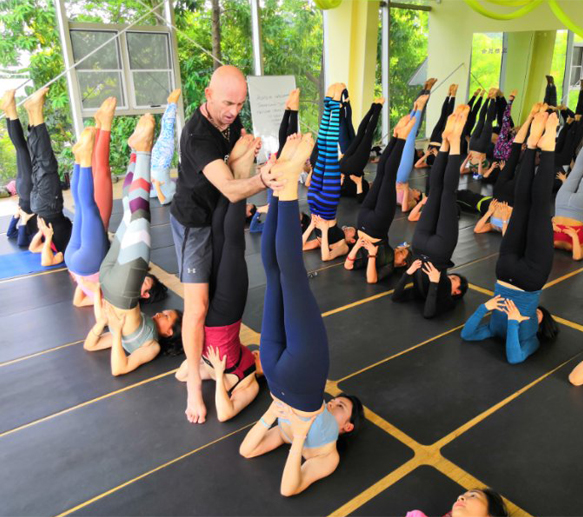
You’ve lived in Mysore for fifteen years, and seen Guruji’s death and Sharath coming into his new role. How was it to watch that transition?
It was very interesting as I started with Sharath just at that time. I witnessed his first conference. Sharath is not a natural public speaker. I think he handled it very, very well at the time. As he’d gone forward he’s become a lot happier with that position. A lot of the old teachers don’t come now because a lot of them have practiced for longer than Sharath has practiced. And they still practice the way that Guruji used to teach them, not the modified version that we practice in the shala today. To these older students, Guruji was their teacher, and I don’t think Sharath can replace that for a lot of those people.
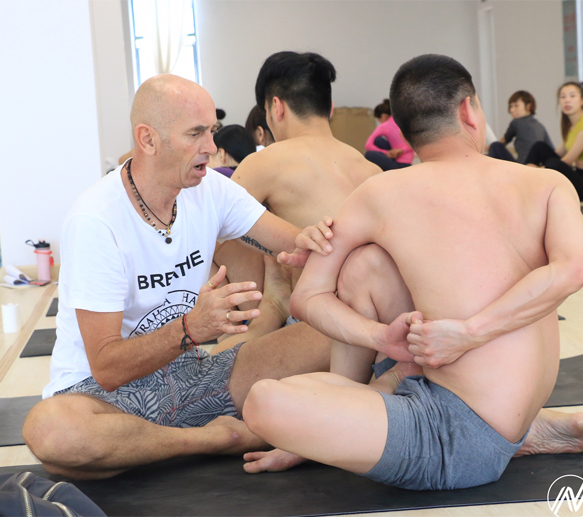
Any final thoughts?
I tell my students in every class: This yoga is the only thing that stops ageing. No botox, no knives, no pills, there’s only yoga that keeps you young. To me that’s one of the greatest things. I don’t want to be an old man in a wheelchair. That’s not my character. I need to be strong and fit and healthy. And I know I can only get that through the pleasure of the ashtanga practice.
Mark Flint lives in Mysore, India with his wife Stephanie — also an authorised KPJAYI teacher — and their son Oliver.
For more information please check: http://www.shantinilayammysore.com/
